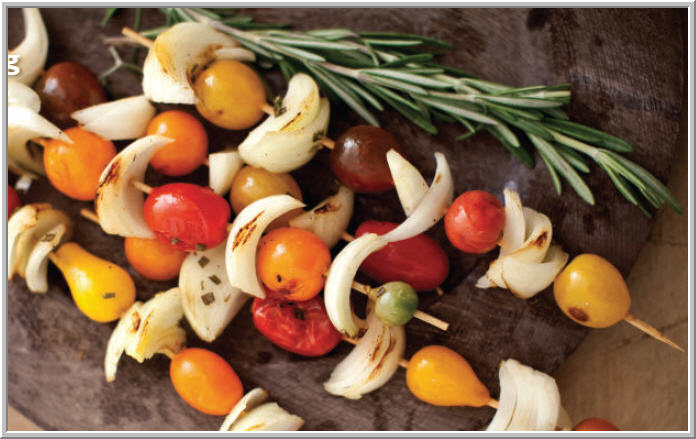Grilling from the garden

CHALK IT UP to the beginning of summer vacation or Father’s Day, but June is a great month for grilling.
It’s also the perfect time to try something colorful, fresh and good for you: fruits and vegetables. You can grill just about any garden goodie, from asparagus to strawberries, apples to sugar snap peas—even edamame!
Vegetables and fruits retain their color and flavor much better when cooked on the grill. They taste wonderful. And they’re easy to prepare.
For vegetables, a simple brush of olive oil and a sprinkle of salt are all you need. Fruits can be directly grilled or planked, grilled on garden skewers (such as branches of rosemary or lavender) or served with grilled pound-cake slices.
Grilling gives even familiar foods a new and exciting makeover—and your backyard barbecue a colorful edge. For example, try cutting a head of cabbage into quarters. Brush each cut side with olive oil, then grill, just on the cut sides, until they have good grill marks. Chop up the cabbage and drizzle it with a Gorgonzola vinaigrette for a slaw that will make family and friends come back for seconds. Arrange a platter of grilled vegetables around a bowl of dipping sauce, and watch them disappear. Toss a large bunch of seedless grapes on the grill, then turn with tongs once so each side has good grill marks—grilled grapes are wonderful to serve on a platter with crème fraîche mixed with a little cinnamon and sugar.
fruits and vegetables
Direct grilling. Most tender fruits and vegetables can go right on hot grill grates. The tricks are a medium-hot to hot fire (so fruits and veggies don’t dry out from long cooking) and a cut shape that’s easy to grill. For example, slice vegetables such as zucchini, yellow squash and eggplant lengthwise so you don’t end up chasing little circles around (and losing them) on a hot grill. Cut peaches or nectarines in half and grill them, cut side down, just until they have good grill marks. Corral small vegetables such as sugar snap peas or fruits such as berries in grill baskets and woks, or thread them onto skewers.
Plank-roasting. Planking is placing foods on a flat piece of untreated hardwood—usually cedar—then placing the planked food on the grill grates. When you want planked foods to be scorched, as with the Plank-Roasted Pear Salad with Blue Cheese and Walnuts, instead of gently burnished, place the plank over direct heat, close the grill lid and cook for a short time (so your plank doesn’t burn up), about 12 to 15 minutes.
Skewering. You can use metal or wooden skewers to create a different vegetable side dish every week. Simply thread what’s freshest onto a wooden or metal skewer without crowding. If you like, marinate them first, as with the Skewered Lemon-Rosemary Cherry Tomatoes (see recipe)
You won’t need any prompting to eat your fruits and vegetables when you give them a delicious sizzle on the grill.
8 to 12 wooden skewers, pre-soaked
24 cherry tomatoes
4 sweet onions, peeled and cut into sixths
¼ cup chopped fresh rosemary leaves
½ cup olive oil
¼ cup fresh lemon juice
Fine kosher or sea salt and freshly ground black pepper to taste
Thread cherry tomatoes and onions alternately on pre-soaked wooden skewers. Place skewered vegetables in a large, shallow baking dish. Combine rosemary, olive oil, lemon juice and seasonings, and pour over vegetables, coating well. Marinate at room temperature for at least 30 minutes, turning 2 or 3 times. Prepare a hot fire in your grill. When ready to grill, place skewered vegetables directly over the fire. Grill for about 10 to 12 minutes, basting frequently with the marinade, until the vegetables are slightly charred. Makes 4 servings.

